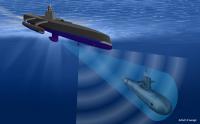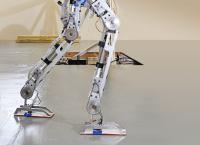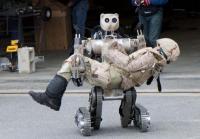-
Snake robot range-sensing control system improves search-and-rescue performance

Rescue operations at disaster scenes often use robots to avoid further human danger. Modelling robots on snakes can provide better access through narrow paths in rubble, but previous models which control snake robots by the head do not adequately avoid collisions between the body of the robot and surrounding obstacles. Researchers say that to be more effective in search and rescue missions, robotic snakes should comprise a series of sections joined by links which either pitch up and down or yaw through sideways turning angles.
-
-
Locust-inspired robot traverses rocky terrain, assists in search and rescue

Since the 1980s, advanced robotic platforms have provided assistance to crisis intervention teams in the wake of man-made and natural disasters. The objective of such robots, in various sizes and shapes, has been to intervene where humans cannot and send life-saving data to rescue teams in the field. A new, locust-inspired robot, can jump eleven feet high — more than twice the height of similar-sized robots — and cover a horizontal distance of 4.5 feet in one leap. The researchers believe the robot will perform well in search-and-rescue missions and in reconnaissance operations in rough terrain.
-
-
Unmanned Maritime Systems 2015 conference: “Reliability, Economy, Endurance”

The theme of the Unmanned Maritime Systems 2015 conference, being held 7-9 December 2015 in Arlington, Virginia, is “Reliability, Economy, Endurance: Requirements for Next-Generation Unmanned Surface and Undersea Systems.” The organizers note that there is a growing demand for Unmanned Maritime Systems (UMS) as today’s geopolitical environment poses a number of unique security challenges in the maritime domain. Advances in power, robotics, computing, sensors, and navigation technologies drive a growing DoD demand for unmanned systems that can provide increased autonomy, persistent resilience, and functionality with decreased risk and expense, showing their value across multiple applications, including otherwise dull, dirty, or dangerous missions.
-
-
Most people object to fully autonomous weapons: Survey

Public opinion is against the use of autonomous weapons capable of identifying and destroying targets without human input, according to a new survey. “It has been said that future wars will be fought with completely automated systems,” said one of the researchers behind the survey. “The survey results clearly show that more public discussion is necessary so that we can make intelligent decisions about robotic weapon technologies.”
-
-
Walking robots a step nearer

Engineers suggests that they have achieved the most realistic robotic implementation of human walking dynamics that has ever been done, which may ultimately allow human-like versatility and performance. The system is based on a concept called “spring-mass” walking that was theorized less than a decade ago, and combines passive dynamics of a mechanical system with computer control. It provides the ability to blindly react to rough terrain, maintain balance, retain an efficiency of motion, and essentially walk like humans do.
-
-
Robots to pull wounded soldiers off battlefield

Most Americans have seen at least one war movie, where at some point a fresh-faced young private is hit with some shrapnel. From the ground, he calls out for the unit medic — another young guy, from another small town, whose quick reaction and skill just may save his life. In the near future, however, it may no longer be another soldier, who comes running to his side. Instead, it might be an Army-operated unmanned aerial or ground vehicle.
-
-
U.S. Navy champions unmanned systems over, on, and under the sea
The presence of unmanned systems in the maritime military domain is growing, and the U.S. Navy has decided to make several organizational, and conceptual, changes in order to deal with unmanned systems in a more holistic fashion. Rear Adm. Robert P. Girrier has been named the Navy’s first director of unmanned weapon systems, and Secretary of the Navy Ray Mabus announced in April that he would appoint a new Deputy Assistant Secretary of the Navy for Unmanned Systems, “so that all aspects of unmanned — in all domains — over, on and under the sea and coming from the sea to operate on land — will be coordinated and championed.”
-
-
Florida teens hold their own in challenging maritime robotics competitions
For the past three years, Team S.S. Minnow from Florida – consisting of Nick Serle, 15, and Abby Butka, 14 – has been competing against some of the finest technical universities in the world via the SeaPerch, RoboSub, and RoboBoat robotic competitions, all cosponsored by the Office of Naval Research (ONR). “I’ve seen Nick and Abby rise through these contests and become fierce competitors,” said Kelly Cooper, a program officer in ONR’s Sea Warfare and Weapons Department. “It is success stories like theirs that motivate us to support these competitions.”
-
-
DHS S&T licenses third cybersecurity innovation for commercialization
The Department of Homeland Security (DHS) Science and Technology Directorate (S&T) yesterday announced that another cybersecurity technology has been licensed for commercialization. This is S&T’s third technology that has successfully gone through the Transition to Practice (TTP) program and into the commercial market. The Network Mapping System (NeMS), developed by Lawrence Livermore National Laboratory, is a software-based tool that tells users what is connected to their network so that they know what needs to be protected.
-
-
RoboBoats compete for water supremacy
In a race for points, honor and cash, sixteen teams — from the United States and as far away as Indonesia, Taiwan, and South Korea — hit the water with custom-built autonomous surface vehicles (ASVs) at the eighth annual RoboBoat Competition, held 7-12 July in Virginia Beach, Virginia. The competition is an autonomous robotics contest where teams put their student-built ASVs through a series of challenges.
-
-
Robots on reins to be the “eyes” of firefighters in dark, smoke-filled buildings
Currently, even when they have a map of the building, firefighters have to grope their way forward if smoke has badly affected visibility, feeling their way along a wall or following ropes laid by the first firefighter on the scene. But with only twenty minutes of oxygen per firefighter, there is a real need for any innovation that can help them move more quickly and easily. Now, firefighters moving through smoke-filled buildings will save vital seconds and find it easier to identify objects and obstacles, thanks to revolutionary reins that enable robots to act like guide dogs.
-
-
Firefighting humanoid robot shows its skills
In fall 2014 in Mobile Bay, Alabama, Virginia Tech engineering students made history during a five-minute demo that placed an adult-sized humanoid robot with a hose in front of a live fire aboard a U.S. Navy ship. The robot located the fire and sprayed water from the hose. Water blasted the flames. The demo, four years in the making, is part of a new effort by the U.S. Navy to better assist sailors in fighting fires, controlling damage, and carrying out inspections aboard ships via user-controlled unmanned craft or humanoid robots.
-
-
Disaster relief robots compete at DARPA Robotics Challenge
Twenty four teams from around the world have just competed in Pomona, California for the Defense Advanced Research Projects Agency’s (DARPA) Robotics Challenge, which runs various rescue robot platforms through a vigorous series of tests to learn and develop better systems. DARPA has made the competition even harder for competing teams. The robots could not operate with power chords, meaning that heavy batteries had to be on the board. Also, there could not be safety pumpers or tools for bipedal robots, which still struggled with balance issues. “In a real disaster, there are no ropes to hold you up. The robots have to drive a car to the door, but the hardest part of the ride is getting out of the vehicle without falling,” said Gill Pratt, program manager of the challenge.
-
-
Winners of DARPA Robotics Challenge Finals announced
“May the best robot win” has been a frequently uttered phrase throughout the DARPA Robotics Challenge (DRC) Finals, held this Friday and Saturday at the Fairplex in Pomona, California. After years of research and development, several intense days of preparation at the competition site, a day of rehearsal and two full days of head-to-head competition in front of thousands of spectators, the verdict is in, and three winners were announced Saturday. The Robotics Challenge was launched in response to a humanitarian need that became glaringly clear during the nuclear disaster at Fukushima, Japan, in 2011. The DARPA Robotics Challenge consisted of three increasingly demanding competitions over two years. The goal was to accelerate progress in robotics and hasten the day when robots have sufficient dexterity and robustness to enter areas too dangerous for humans and mitigate the impacts of natural or man-made disasters.
-
-
Robots to the rescue in disaster situations
Real-life disaster scenarios have awakened the robotics community to the limitations of existing emergency-response robots. EU-funded researchers are redoubling efforts to ensure that disaster response robots can better support rescue workers in future emergencies. Research in the lab and on-site simulations have helped in improving the capabilities of emergency-response robots in recent years. When real disaster strikes unexpected, however, complications lay bare the limitations of test scenarios. In light of the lessons learned following the Fukushima nuclear accident, researchers are following a range of different pathways to advance emergency-response robotics.
-
- All
- Regional
- Water
- Biometrics
- Borders/Immig
- Business
- Cybersecurity
- Detection
- Disasters
- Government
- Infrastructure
- International
- Public health
- Public Safety
- Communication interoperabillity
- Emergency services
- Emergency medical services
- Fire
- First response
- IEDs
- Law Enforcement
- Law Enforcement Technology
- Military technology
- Nonlethal weapons
- Nuclear weapons
- Personal protection equipment
- Police
- Notification /alert systems
- Situational awareness
- Weapons systems
- Sci-Tech
- Sector Reports
- Surveillance
- Transportation
Advertising & Marketing: advertise@newswirepubs.com
Editorial: editor@newswirepubs.com
General: info@newswirepubs.com
2010-2011 © News Wire Publications, LLC News Wire Publications, LLC
220 Old Country Road | Suite 200 | Mineola | New York | 11501
Permissions and Policies
Editorial: editor@newswirepubs.com
General: info@newswirepubs.com
2010-2011 © News Wire Publications, LLC News Wire Publications, LLC
220 Old Country Road | Suite 200 | Mineola | New York | 11501
Permissions and Policies
